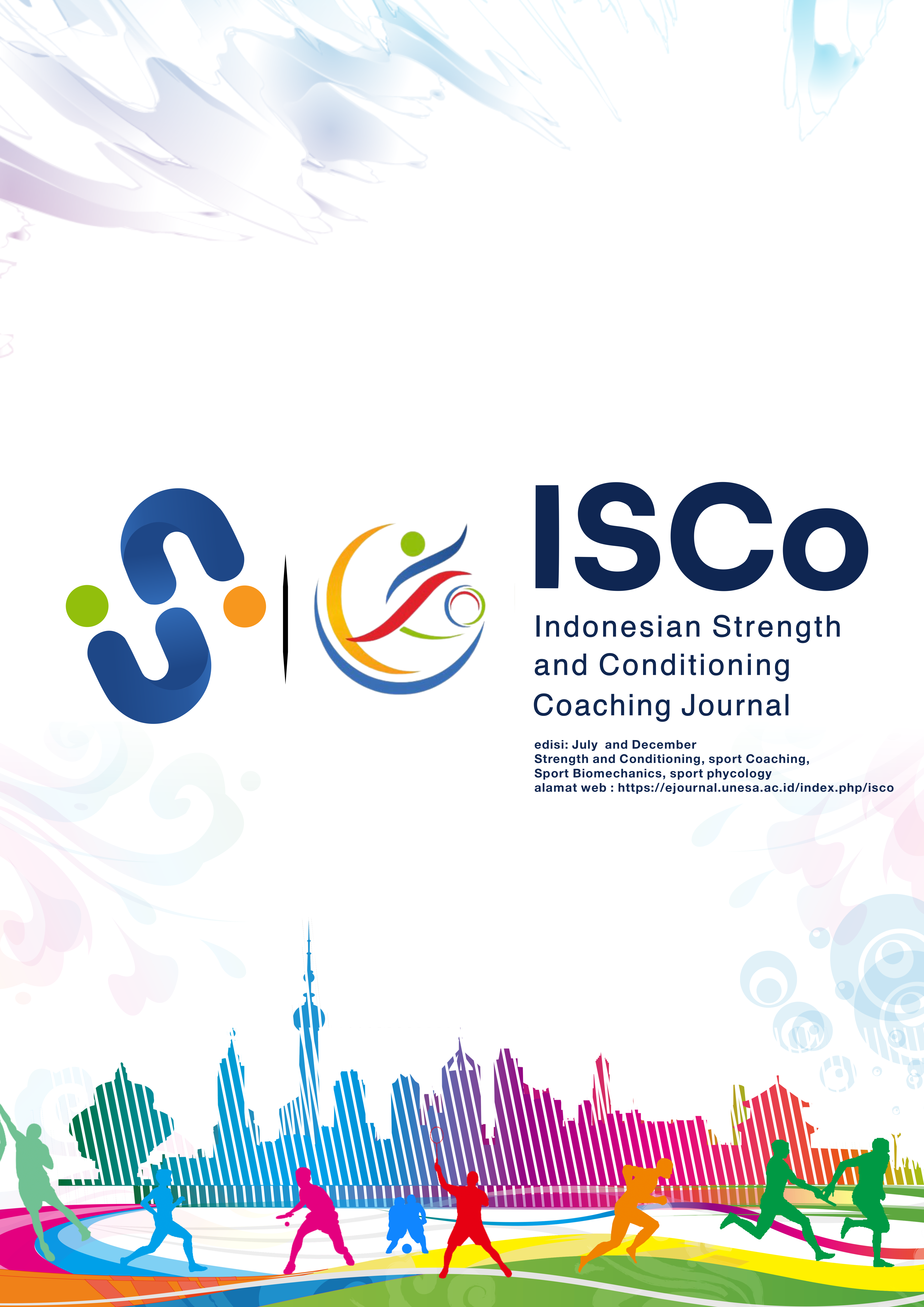PENERAPAN MODEL LATIHAN BODYWEIGHT TRAINING TERHADAP PERFORMA FISIK ATLET MUDA
PENERAPAN MODEL LATIHAN BODYWEIGHT TRAINING TERHADAP PERFORMA FISIK ATLET MUDA
Keywords:
kondisi fisik, Latihan, Performa fisik, Atlet muda, Program latihan, Tes pengukuran, dan BasketAbstract
Performa fisik merupakan faktor utama dalam mendukung prestasi atlet muda. Latihan yang terstruktur sejak dini tidak hanya meningkatkan kebugaran, tetapi juga meminimalkan risiko cedera dan mendukung koordinasi motorik. Dalam olahraga bola basket, kondisi fisik optimal sangat penting untuk mendukung kecepatan, kekuatan, daya tahan, dan kelincahan agar atlet mampu bermain maksimal. Atlet muda dengan kemampuan fisik baik cenderung tampil konsisten dan kompetitif di lapangan. Salah satu metode efektif dalam pengembangan performa fisik adalah bodyweight training. Latihan ini menggunakan berat tubuh sendiri sebagai resistensi dalam gerakan seperti Parallel box squats, Hip bridge, Shoulder Taps, Bench dips, Plank, Mountain climbers, dan Jump squat. Model latihan ini bertujuan meningkatkan kekuatan otot, keseimbangan, koordinasi, serta daya ledak, dan bisa dilakukan tanpa alat khusus sehingga fleksibel untuk berbagai kondisi. Penelitian ini bertujuan menganalisis pengaruh bodyweight training terhadap performa fisik atlet muda CLS Academy KU-14 putra di Surabaya. Metode penelitian menggunakan pendekatan eksperimen semu dengan tes pengukuran keseimbangan, koordinasi, kekuatan otot, dan power. Hasil penelitian menunjukkan adanya peningkatan signifikan dalam biomotor fisik, seperti Standing Stork Test, Alternate Hand Wall Toss, Vertical Jump, Push Up, dan Sit Up. Selain peningkatan fisik, indeks kepuasan atlet terhadap program ini tergolong sangat tinggi. Atlet merasa latihan ini efektif, menyenangkan, variatif, dan menantang. Selain itu, latihan ini juga meningkatkan motivasi, rasa percaya diri, dan kesiapan mental dalam menghadapi tekanan pertandingan. Bodyweight training terbukti menjadi metode yang efektif dan aplikatif dalam meningkatkan performa fisik dan aspek psikologis atlet muda bola basket.
Downloads
References
REFERENSI
Asadi, A. 2017. The effects of plyometric training on change-of-direction ability: A meta-analysis. International Journal of Sports Science & Coaching, 12(5): 655–673.
Behm, D. G. 2021. The effectiveness of resistance training using different modalities. Sports Medicine, 51(2): 333–357.
Ben Abdelkrim, N. 2010. The effect of players’ standard and playing time on activity profile, heart rate and blood lactate in basketball. Journal of Strength and Conditioning Research, 24(10): 2652–2662.
Bompa, T. O. 2019. Peridization: Theory and Methodology of Training. Journal of Chemical Information and Modeling, 6(6).
Calatayud, J. 2015. Muscle activation during push-ups with different suspension training systems. Journal of Strength and Conditioning Research, 29(9): 2538–2543.
Castagna, C. 2009. Relation between maximal aerobic power and the ability to recover in basketball. International Journal of Sports Physiology and Performance, 4(4): 291–297.
Faigenbaum, A. D. 2018. Youth resistance training: Past practices, new perspectives, and future directions.
Page |
Page |
Indonesia Strength Conditioning and Coaching Journal
Volume 2, No. 1, Edition July 2024
Journal of Sport and Exercise Science, Vol X, No Y, 20XX (AA-BB)
Penulis Pertama1, Penulis Kedua2, Penulis Ketiga3 (Calibri (Body)(11))
Pediatric Exercise Science, 30(1): 60–66.
Granacher, U. 2016. Effects of resistance training in youth athletes on muscular fitness and performance: A conceptual model for long-term athlete development. Frontiers in Physiology, 7: 164.
Harries, S. K. 2018. Resistance training to improve power and sports performance in adolescent athletes: A systematic review and meta-analysis. Sports Medicine, 48(5): 1003–1016.
Harsono. 2018. Latihan Kondisi Fisik. P. Latifah (Ed.); Pertama. PT Remaja Rosdakarya Offset.
Hoare, D. G. 2000. Predicting success in junior elite basketball players—The contribution of anthropometric and physiological attributes. Journal of Science and Medicine in Sport, 3(4): 391–405
Lloyd, R. S. 2019. Chronological age vs. biological maturation: Implications for exercise programming in youth. Journal of Strength and Conditioning Research, 33(8): 2371–2381.
McGill, S. M. 2012. Core training: Evidence translating to better performance and injury prevention. Strength & Conditioning Journal, 34(2): 33–46.
Nikolaidis, P. T. 2014. Associations of age and sex with physical fitness in team sports athletes. Science & Sports, 29(4): 237–244.
Ziv, G. 2010. Vertical jump in female and male basketball players: A review of observational and experimental studies. Journal of Science and Medicine in Sport, 13(3): 332–339.
Downloads
Additional Files
Published
How to Cite
 Abstract views: 126
,
Abstract views: 126
, PDF Downloads: 46
,
PDF Downloads: 46
, PDF Downloads: 0
PDF Downloads: 0







